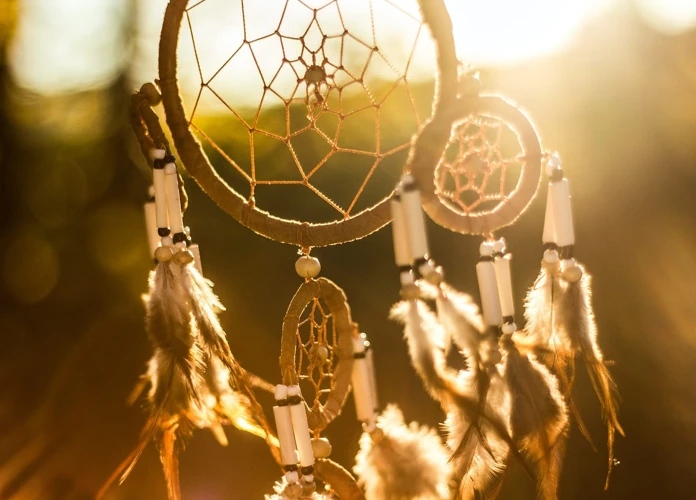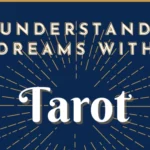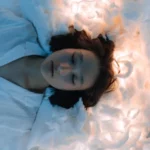Dream catchers have intrigued and captivated people for centuries, with their delicate webs and intricate designs. These symbolic creations hold deep meanings and interpretations that go beyond their aesthetic appeal. Embarking on a journey to understand the profoundness of dream catchers reveals the secrets behind their origin, symbolism, and cultural significance. Delve into the realm of dream catchers to explore the diverse beliefs, interpretations, and modern uses of these intriguing talismans. Unveil the mysteries of dream catchers and discover how they can bring positive energy, protection, and spiritual connection into our lives.
The Origin of Dream Catchers
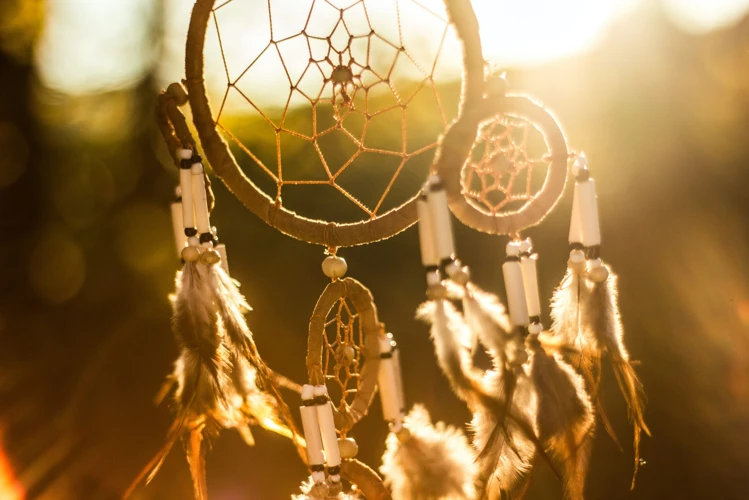
The Origin of Dream Catchers can be traced back to the indigenous cultures of North America, particularly the Native American tribes. The roots of these mystical creations are shrouded in legends and traditions, making their history captivating and intriguing. One prominent legend associated with dream catchers is that of the Ojibwe Tribe, who believe that these talismans originated from Asibikaashi, the Spider Woman. According to the legend, Asibikaashi would weave her intricate webs to protect their children from bad dreams and nightmares. As the Ojibwe people spread across the land, it became difficult for her to reach every child, and so the dream catchers were created to continue the task of filtering dreams and ensuring peaceful slumber. With its rich and mythical origins, the significance of dream catchers in Native American culture is deep-rooted and has transcended time to become a symbol of wisdom, protection, and spirituality.
1. Native American Legends
Native American legends play a significant role in the origin and mythology surrounding dream catchers. According to these legends, dream catchers were created by the Spider Woman, known as Asibikaashi in the Ojibwe Tribe. She would weave intricate webs to protect children from bad dreams and nightmares. As the Ojibwe people migrated, they became concerned that she couldn’t reach every child and thus began crafting dream catchers to continue the task of filtering dreams. The legends highlight the belief in the power of the dream catcher to capture negative energy and promote peaceful sleep. These legends are an integral part of Native American culture and contribute to the symbolism and spiritual significance tied to dream catchers.
2. Ojibwe Tribe Tradition
The Ojibwe Tribe has a rich tradition associated with dream catchers. According to their beliefs, dream catchers were initially created by Asibikaashi, the Spider Woman, who protected children from bad dreams and nightmares. However, as the tribe expanded, it became challenging for Asibikaashi to reach every child. To continue the task, the Ojibwe people started making dream catchers themselves. These dream catchers typically feature a circular shape representing the cycle of life, a web woven with threads to catch and filter out negative dreams, and feathers attached to bring positive energy and gentle sounds. The Ojibwe Tribe holds dream catchers in high regard, valuing them as sacred items that bring protection and guidance. While the dream catcher tradition originated with the Ojibwe Tribe, its symbolism and popularity have spread far beyond their community.
The Symbolism of Dream Catchers
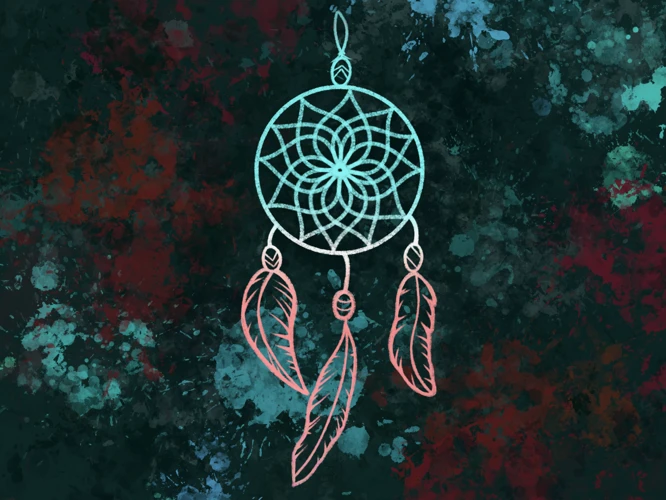
The Symbolism of Dream Catchers goes beyond their intricate designs and delicate webs. They hold deep meanings that are intertwined with spirituality and protection. One of the main purposes of a dream catcher is to filter dreams and capture positive energies while warding off negative ones. It is believed that as dreams pass through the web, the negativity gets entangled, while the positive dreams and visions glide smoothly down the feathers to reach the dreamer. The circular shape symbolizes the circle of life and unity, while the web represents the intricate interconnectedness of all life’s experiences. Dream catchers also serve as a spiritual connection to higher energies, acting as a bridge between the dreamer and the spiritual realm. The feathers attached to the dream catcher are often associated with air and represent communication with the divine. Each component of a dream catcher holds its own significance, creating a powerful symbol of protection, positivity, and spiritual guidance in dreams and beyond.
1. Protection and Filtering Dreams
Dream catchers are believed to have the power to protect and filter dreams, as their intricate webs trap negative energies and nightmares, allowing only positive and peaceful dreams to pass through. According to Native American traditions, the web of the dream catcher acts as a shield, capturing the bad dreams and preventing them from reaching the dreamer. This filtering process ensures that only good dreams flow down the feathers and gently enter the sleeper’s mind. The dream catcher thus serves as a spiritual tool, promoting restful sleep and warding off negative influences during the night. By hanging a dream catcher near your sleeping area, you can invite a sense of tranquility and protection into your dreams, allowing for a more peaceful and fulfilling sleep experience.
2. Positive Energy Capture
Positive Energy Capture is another significant aspect of dream catchers. These symbolic creations are believed to have the power to attract and capture positive energy from the surrounding environment. The intricate web woven within the circular frame is thought to act as a filter, allowing only positive energy to pass through and trapping any negative energy or bad dreams. As a result, dream catchers are believed to promote a harmonious and positive atmosphere, bringing good fortune and well-being to those who possess them. The capturing of positive energy within the dream catcher’s web is a testament to its powerful symbolism and its ability to create a sacred space for positive energy to thrive.
3. Spiritual Connection
Dream catchers hold a profound spiritual connection for those who believe in their power. They are thought to not only filter dreams but also serve as a gateway to the spiritual realm. Some individuals use dream catchers as a tool for meditation and enhancing their spiritual practices. The circular shape of the dream catcher is believed to symbolize the circle of life and the ongoing cycle of birth, death, and rebirth. The web within the hoop represents the interconnectedness of all living beings and the intricate threads of fate that weave our lives together. By hanging a dream catcher near one’s sleeping area or in a sacred space, individuals seek to establish a stronger connection with their spirituality and the unseen forces that guide their lives. It becomes a reminder of the importance of staying connected to one’s inner self and the larger spiritual world around them.
The Design and Components
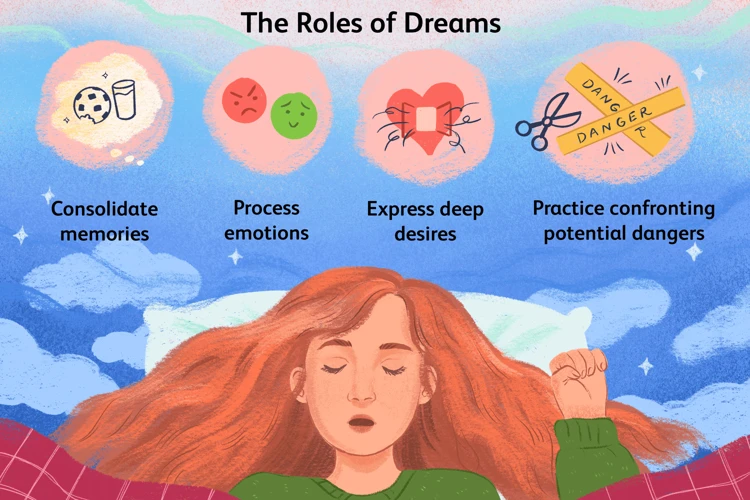
The design and components of dream catchers play a significant role in their symbolism and purpose. The most recognizable feature of a dream catcher is its circular shape, representing the circle of life and the interconnectedness of all things. The hoop, typically made from a flexible material like willow, forms the foundation of the dream catcher. It is within this hoop that the intricate web is woven, resembling a spider’s web. The web is believed to catch and filter out negative dreams, allowing only positive ones to pass through and reach the dreamer. The strands of the web often have symbolic meanings, such as unity, harmony, and balance. Additionally, feathers are commonly attached to the bottom of the dream catcher, representing the breath of air and serving as a conduit for good dreams to flow down to the dreamer. Beads are sometimes woven into the web, symbolizing the spider’s sacred energy and adding another layer of spiritual significance. Each component of a dream catcher contributes to its overall symbolism and enhances its unique ability to capture and filter dreams, allowing for a restful and peaceful sleep.
1. Circular Shape
The circular shape is a key component of dream catchers. This shape represents the circle of life, symbolizing the cycle of birth, growth, death, and rebirth. In Native American traditions, circles hold significant spiritual meaning as they represent unity, connection, and the eternal flow of energy. The circular shape of a dream catcher is believed to create a protective barrier against negative forces and ensure the continuous flow of positive energy. It is a visual representation of the interconnectedness of all things and serves as a reminder to embrace the harmony and balance within the universe. The circular shape of the dream catcher also mirrors the shape of the sun and the moon, further amplifying its symbolism of divine energy and celestial guidance.
2. Hoop
The hoop is a crucial component of a dream catcher, representing the circle of life and unity. It is typically made of a flexible material like willow or grapevine, carefully shaped into a round form. The circular shape of the hoop symbolizes the eternal cycle of life, with no beginning or end. Ancient wisdom suggests that negative energy and bad dreams get trapped in the web of the dream catcher, while positive energy and good dreams pass through the hoop and flow down to the person sleeping below. The hoop also acts as a boundary, keeping away negative influences and allowing only positive energies to enter. Its significance lies in its ability to create a safe and harmonious space for peaceful dreams to occur.
3. Web
The web of a dream catcher holds significant symbolism in its design. Typically created using a woven pattern, the web is believed to capture and filter dreams as they pass through it during the night. According to Native American beliefs, the web acts as a protective barrier, trapping any negative or bad dreams while allowing positive and peaceful ones to pass through. It is said that as the morning sunlight reaches the dream catcher, the negative dreams caught in the web dissipate and disappear. This intricate web serves as a reminder of the importance of filtering our thoughts and experiences, allowing only positivity and harmony to enter our lives. The web of a dream catcher symbolizes the power of intention and mindfulness in our dream realms and daily existence.
4. Feathers
Feathers hold a significant role in the design of dream catchers. They are often attached to the bottom of the dream catcher, dangling delicately. Feathers symbolize air and the breath of life in Native American culture. They are believed to help guide good dreams down to the dreamer. Each feather is seen as a conduit for communication with the spiritual realm. The choice of feathers used in a dream catcher can vary, with different feathers carrying different meanings. For instance, eagle feathers are highly esteemed and represent strength and courage, while owl feathers symbolize wisdom and intuition. The presence of feathers in a dream catcher adds a touch of beauty and grace, enhancing its spiritual connection and power.
5. Beads
Beads are an integral component of dream catchers, adding a touch of beauty and symbolism to these intricate creations. The beads used in dream catchers hold their own significance and contribute to the overall meaning of the talisman. Each bead represents a unique energy or intention, adding depth to the purpose of the dream catcher. Different colors and materials of beads can evoke different emotions or bring specific energies into the dream catching process. For example, red beads may symbolize strength and courage, while blue beads can represent tranquility and peace. The placement of beads within the web or around the hoop can also vary, allowing for personalization and intention setting when crafting or selecting a dream catcher. These small yet powerful adornments enhance the visual appeal and spiritual significance of dream catchers, amplifying their ability to protect, filter, and capture positive dreams and energies.
Dream Catchers in Different Cultures
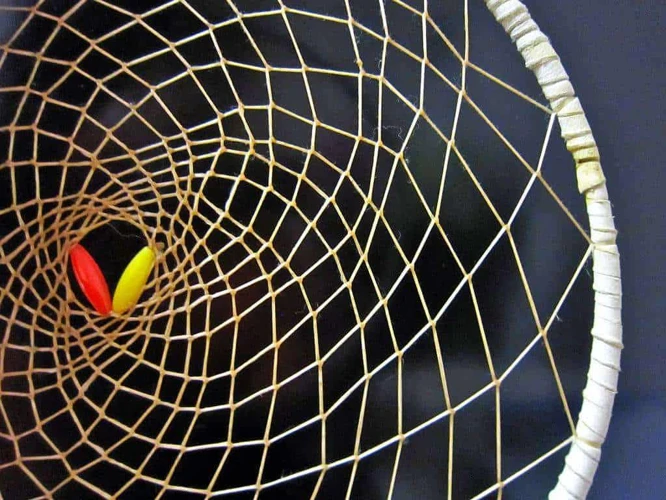
Dream catchers have transcended their Native American origins and gained popularity in various cultures around the world. While they may have different names and variations, the underlying meaning remains consistent. In the Ojibwe Tribe, dream catchers hold immense significance as protectors against bad dreams and negative energies. Additionally, dream catchers can also be found in the Lakota Tribe, where they are associated with the Spider Woman and considered sacred objects. In modern times, dream catchers have become popular in mainstream culture, admired for their aesthetics and believed to bring positive energy and good luck. Whether it’s the ancient beliefs of the Ojibwe and Lakota Tribes or the contemporary fascination with these symbolic creations, dream catchers continue to hold a special place in the hearts and minds of people all around the world.
1. Ojibwe Tribe
The Ojibwe Tribe holds a significant place in the history and tradition of dream catchers. According to their belief, dream catchers were created by Asibikaashi, the Spider Woman, to protect children from bad dreams and nightmares. The Ojibwe people see dream catchers as powerful guardians that filter out negative dreams and allow only positive ones to pass through. These intricate talismans, with their carefully woven webs and sacred symbolism, are deeply ingrained in Ojibwe culture and continue to be revered as instruments of protection and spiritual connection. To the Ojibwe Tribe, dream catchers are not just decorative items, but powerful tools that bring comfort and harmony to their lives and dreams.
2. Lakota Tribe
The Lakota Tribe has a significant connection to dream catchers as well. In Lakota culture, dream catchers are believed to have the power to capture both good and bad dreams, similarly to other Native American tribes. However, they also associate dream catchers with the Spider Woman, who is considered a sacred figure in their beliefs. The Lakota Tribe views dream catchers as a way to connect with their ancestors and seek guidance from the spiritual realm. They believe that dream catchers can assist in receiving messages and visions during dreams, allowing individuals to gain insight and understanding. The use of dream catchers within the Lakota Tribe showcases the diverse cultural significance of these symbolic creations.
3. Modern Popularity
Modern Popularity:
– In recent years, dream catchers have gained immense popularity beyond Native American cultures. They have become widely recognized as beautiful and meaningful decorations, finding their way into homes, offices, and various other spaces.
– One reason for their modern popularity is their aesthetic appeal. Dream catchers are often intricately designed with vibrant colors, feathers, and beads, making them visually appealing and attractive to many.
– Additionally, dream catchers have also become popular due to their symbolism and the positive energy they are believed to bring. Many people are drawn to the idea of having a talisman that can filter out negative dreams and promote peaceful sleep.
– Dream catchers have also found their place in popular culture, showing up in art, fashion, and even tattoos. This exposure has contributed to their increasing popularity and widespread recognition.
– With the rise of the internet and e-commerce, it has become easier than ever to find and purchase dream catchers. Online platforms offer a wide range of choices, allowing people to select dream catchers that resonate with them personally.
– The modern popularity of dream catchers can be attributed to their symbolism, aesthetics, and the growing interest in spiritual and mindful practices.
(Note: You can add an internal link if desired)
Interpreting Dream Catchers in Dreams
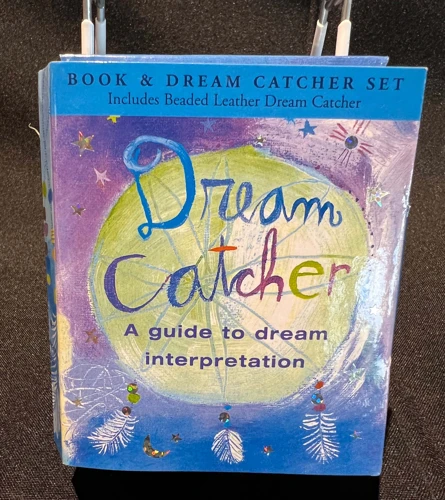
Interpreting Dream Catchers in Dreams unveils a fascinating realm where symbolism intertwines with the subconscious. When dream catchers appear in our dreams, they often carry significant messages and provide insight into our emotional and spiritual state. Catching dreams in a dream catcher is believed to signify the ability to filter and process one’s experiences and emotions, bringing clarity and understanding. However, a dream catcher that appears broken in a dream can indicate a sense of vulnerability and the need for protection against negative energies. The gift of a dream catcher in a dream symbolizes a connection to one’s spirituality and the potential for personal growth. By paying attention to these dream symbols and their unique interpretations, we can uncover hidden meanings and gain valuable guidance from our dreams. (For more information on dream symbolism, refer to our guide on /seeing-broken-glass-in-dream-meaning/)
1. Catching Dreams
– The concept of catching dreams is central to the symbolism of dream catchers. According to Native American beliefs, dream catchers are believed to filter dreams, capturing the negative ones while allowing positive ones to flow through. The intricate web woven within the dream catcher is said to catch bad dreams, entangling them in the web until they dissolve with the first light of day. The good dreams, on the other hand, pass through the hole in the center and gently glide down the feathers to reach the sleeping individual. This symbolism emphasizes the importance of promoting positive energy, protecting individuals from nightmares, and ensuring a restful night’s sleep. The act of catching dreams acts as a powerful reminder to focus on positivity and harness the potential within our dreams.
2. Broken Dream Catcher
A broken dream catcher holds a significant meaning in the realm of dreams and symbolism. When a dream catcher is broken, it is believed to have fulfilled its purpose and has absorbed negative energies or trapped bad dreams. In the context of dreams, a broken dream catcher may indicate a disrupted spiritual connection or a need for renewal and protection. It could signify a time of transition or a call to repair and restore balance within oneself. Just as the broken pieces of a dream catcher can be mended, dreams broken by negative influences can also be restored, providing an opportunity for personal growth and healing. Understanding the symbolism behind a broken dream catcher can guide individuals towards addressing the challenges they face in their dreamscapes and waking lives. For more insights into dream symbolism, you can explore the meaning of broken nails in dreams.
3. Gift of a Dream Catcher
Receiving a gift of a dream catcher holds great significance and carries a profound message. When someone gifts you a dream catcher, it symbolizes their desire to bring positivity, protection, and well-being into your life. It is believed that the giver has carefully chosen the dream catcher to suit your needs and wishes, recognizing the power of these symbolic talismans. The act of gifting a dream catcher can also represent a spiritual connection between the giver and the receiver, as they share the intention of promoting good dreams and warding off negative energies. It is a gesture of love, support, and hope for a peaceful and harmonious life. By receiving a dream catcher as a gift, you are not only acquiring a beautiful object but also embracing the positive energy and blessings it carries. It serves as a constant reminder of the affection and thoughtfulness of the person who gifted it to you, making it a cherished possession that brings comfort and inspiration. So, if you ever receive the gift of a dream catcher, treasure it and let its symbolism guide you towards a path of positivity and serenity.
The Modern Meaning and Use of Dream Catchers
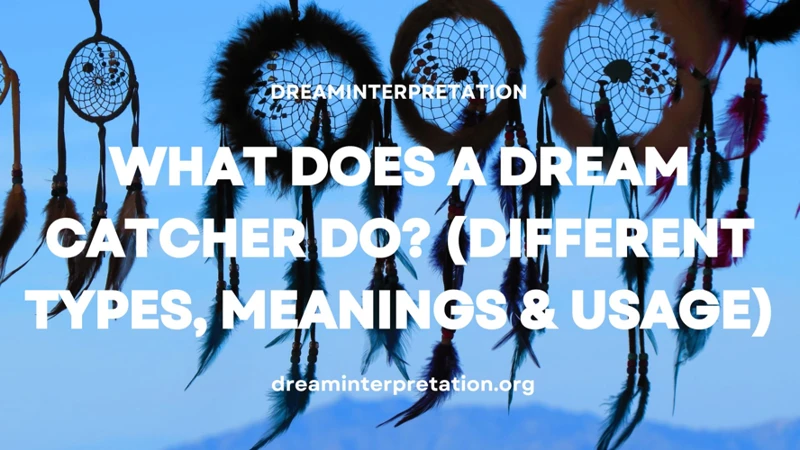
The Modern Meaning and Use of Dream Catchers has evolved over time, extending beyond their traditional purpose. Today, dream catchers are not only seen as decorative items but also as symbols of positivity, mindfulness, and spirituality. They have found their way into various aspects of modern life, including home decor, jewelry, and even tattoos. Many people embrace dream catchers as a way to invite good dreams, ward off negative energy, and promote a sense of peace and tranquility in their surroundings. They serve as gentle reminders to stay connected to one’s dreams, aspirations, and inner self. Additionally, dream catchers have become popular gifts that carry heartfelt intentions and blessings for loved ones. Whether displayed in a bedroom, meditation space, or car rearview mirror, dream catchers continue to hold meaning and serve as powerful symbols in the modern world.
Creating or Purchasing a Dream Catcher
Creating or purchasing a dream catcher allows individuals to embrace the spiritual and symbolic essence of these enchanting talismans. If you possess a creative inclination, making your own dream catcher can be a deeply fulfilling and personal experience. You can start by gathering the necessary materials, including a hoop or circular frame, string or thread, feathers, and beads. As you intricately weave the web, channel your intentions and positive energy into each intricate knot. Alternatively, if crafting isn’t your forte, numerous artisans and crafters specialize in crafting and selling dream catchers. When purchasing a pre-made dream catcher, consider the design, size, and overall aesthetic that resonates with you. Whether you decide to create a custom dream catcher or choose one that speaks to your soul, the process of creating or purchasing one becomes a pathway to connect with the symbolic and spiritual realm that dream catchers encompass.
1. Making Your Own Dream Catcher
To embark on the creative journey of making your own dream catcher, you will need a few materials. Start by gathering a hoop, traditionally made from willow branches, but you can also use metal or wooden hoops. Next, choose a string or strong thread that resonates with you, such as natural fibers or colorful yarns. Begin by tying one end of the string to the hoop and then start weaving a web-like pattern, crisscrossing the string across the hoop to create a net. Remember to leave a hole in the center, as this is believed to let good dreams pass through. Once you’ve completed the web, you can adorn your dream catcher with feathers, beads, or other meaningful charms. Each element holds symbolism, so choose them thoughtfully to enhance the energy and intention of your creation. Dreaming with feces may seem unusual, but it is a common dream experience that can hold symbolic meanings. Whether you decide to make your own dream catcher or purchase one, these intricate creations can be a beautiful addition to your space and a reminder of the significance of filtering dreams and inviting positive energy into your life.
2. Choosing the Right Dream Catcher
When choosing the right dream catcher, there are several factors to consider. Firstly, consider the size of the dream catcher. Smaller dream catchers are ideal for individual use, such as hanging above a bed or in a specific space for personal dreams and protection. Larger dream catchers, on the other hand, can be used as decorative pieces in larger areas or as ceremonial objects. Secondly, pay attention to the materials used. Traditional dream catchers are made from natural materials like wood, sinew, and feathers, while modern ones may incorporate beads, crystals, or other embellishments. Consider the materials that resonate with you and align with your intentions for the dream catcher. Lastly, trust your intuition. When selecting a dream catcher, allow yourself to be drawn to the one that feels right for you. It’s important to connect with the energy and aesthetics of the dream catcher to enhance its effectiveness in catching dreams and promoting positive energy.
Conclusion
In conclusion, dream catchers hold a significant place in various cultures, resonating with their symbolism and spiritual essence. These symbolic creations bring a sense of protection, positive energy, and interconnectedness with the spiritual realm. The origin stories, designs, and interpretations may differ among different tribes and cultures, but the underlying belief in the power of dream catchers remains strong. Whether it is used as a decoration, a tool for filtering dreams, or a spiritual talisman, dream catchers continue to capture our imagination and serve as a reminder of the importance of dreams and the possibilities they hold. Embrace the enchanting world of dream catchers to unlock the secrets of your subconscious and invite positivity into your life.
Frequently Asked Questions
1. How do dream catchers work?
Dream catchers are believed to work by capturing negative dreams and allowing positive ones to pass through. The intricate webbing acts as a filter, trapping bad dreams and nightmares, while allowing good dreams to enter the sleeping individual’s subconscious.
2. Can dream catchers protect against bad spirits?
According to Native American belief, dream catchers serve as a protective talisman against negative spirits and energies. The webbing is thought to entangle and ward off evil spirits, ensuring a peaceful and undisturbed sleep.
3. How can dream catchers bring positive energy?
Dream catchers are believed to attract positive energy from the universe. The feathers and other sacred objects attached to the dream catcher are believed to amplify positive energy and bring it into the sleeping individual’s space, promoting harmony and positivity.
4. Are dream catchers only used for dreaming purposes?
While dream catchers are primarily associated with dreaming, they also hold significance beyond that realm. Many people hang them in their homes as decorative pieces, believing that they bring good luck, positive energy, and protection to their living spaces.
5. Can anyone use a dream catcher?
Yes, dream catchers can be used by anyone regardless of their cultural background or beliefs. They have gained popularity worldwide, and many people of different cultures find comfort in having a dream catcher hanging in their space.
6. How can I interpret the symbols on a dream catcher?
Interpretation of the symbols on a dream catcher can vary depending on personal beliefs and cultural associations. It is always best to trust your intuition and reflect on the symbols that resonate with you personally. Additionally, researching the cultural significance of certain symbols can provide insights into their meanings.
7. Can dream catchers stop all nightmares?
While dream catchers are believed to help filter out negative dreams, they may not completely eliminate all nightmares. They serve as a tool to promote positive dreams and protect against excessive nightmares, but individual experiences may vary.
8. Can dream catchers bring inspiration and creativity?
Yes, dream catchers are often associated with promoting inspiration and creativity. Hanging a dream catcher near your workspace or creative area is believed to attract positive energy and help stimulate imaginative thoughts and ideas.
9. What materials are traditionally used to make dream catchers?
Traditionally, dream catchers are made using a wooden hoop, usually wrapped in leather or fabric. The webbing is created using a sinew or string, and feathers, beads, and other sacred objects are incorporated into the design.
10. Can I customize my own dream catcher design?
Absolutely! Customizing your own dream catcher design allows you to infuse personal meaning and intention into the creation. You can choose specific colors, feathers, and symbols that hold significance to you, making the dream catcher truly unique and meaningful.

